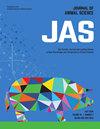产前卫生习惯(次标准vs最佳)和蠕变饲喂方式(干颗粒状起始日粮vs乳化剂和起始日粮的液体混合物)对猪断奶后肠道参数和生长至屠宰的影响
IF 2.7
2区 农林科学
Q1 AGRICULTURE, DAIRY & ANIMAL SCIENCE
引用次数: 0
摘要
本试验旨在评价在卫生条件较差或较优的猪舍中饲喂干颗粒状起始日粮(DPS)或乳代用品与起始日粮的液体混合物(LMR+S)对猪的生长和断奶后肠道参数的影响。在妊娠第107天(d), 87头母猪按2×2因子排列随机分配到4个处理中的一个。影响因素为蠕变饲养(DPS或LMR+S)和分娩前卫生常规(不合标准或最佳)。在第11天至断奶(d28±1.2日龄)期间,采用人工饲喂DPS;在第4天至断奶期间,采用自动液体饲喂系统饲喂LMR+S。在母猪进入产房前,分别采用次标准卫生程序(猪舍清洗和干燥18小时,母猪不清洗或消毒)和最佳卫生程序(猪舍预浸泡,使用洗涤剂,清洗和干燥3天,使用氯甲酚类消毒剂,再干燥3天,母猪使用Virkon清洗和消毒)获得次标准或最佳卫生条件。在断奶前和第21和114胎重时,对8头病灶猪/治疗组的粪便样本进行微生物组分析。在PW第4天,每组10头猪实施安乐死,收集肠组织和食糜样本进行组织学、酶活性和微生物组分析。在最佳卫生条件下饲喂LMR+S的猪,与其他各组相比,总干物质采食量显著增加(P≤0.05),断奶重显著增加(P≤0.05)。最佳猪圈的猪临床发病和腹泻率低于次标准猪圈,屠宰期比次标准猪圈早3.8 d (P≤0.05)。LMR+S降低了乳猪死亡率(P≤0.05)。在第4胎时,优化卫生组提高了空肠和回肠绒毛高度,LMR+S组提高了回肠蔗糖酶活性(P≤0.05)。在第4 PW时,最佳猪圈LMR+ s喂养的猪空肠中Clostridium_P相对丰度较低。综上所述,最佳卫生习惯提高了断奶前LMR+S采食量,减少了临床疾病病例,改善了肠道结构,缩短了断奶至屠宰时间,而LMR+S饲喂提高了断奶体重、肠道成熟度,降低了断奶前死亡率。本文章由计算机程序翻译,如有差异,请以英文原文为准。
Effect of pre-farrowing hygiene routine (sub-standard vs. optimal) and creep feeding regime (dry pelleted starter diet vs. liquid mixture of milk replacer and starter diet) on post-weaning intestinal parameters and growth to slaughter in pigs
The objective was to evaluate the effect of providing dry pelleted starter diet (DPS) or a liquid mixture of milk replacer and starter diet (LMR+S) to suckling pigs housed in farrowing pens of sub-standard or optimal hygiene conditions on pig growth to slaughter, and post-weaning (PW) intestinal parameters. On day (d) 107 of gestation, 87 sows were randomly allocated to one of four treatments in a 2×2 factorial arrangement. The factors were creep feeding (DPS or LMR+S) and pre-farrowing hygiene routine (SUB-STANDARD or OPTIMAL). Pigs were provided with DPS (manually) from d11 to weaning (at d28±1.2 of age) or LMR+S using an automatic liquid feeding system from d4 to weaning. The SUB-STANDARD hygiene routine (pens washed and dried for ~18 h, sows not washed or disinfected) and the OPTIMAL hygiene routine (pens pre-soaked, detergent applied, washed, dried for 3 days, chlorocresol-based disinfectant applied, dried for 3 more days and sows washed and disinfected with Virkon) were used to obtain SUB-STANDARD or OPTIMAL hygiene conditions, respectively in farrowing rooms prior to entry of sows. Microbiome analysis was performed on fecal samples from 8 focal pigs/treatment, before weaning and at d21 and d114 PW. On d4 PW, 10 pigs/treatment were euthanized to collect intestinal tissue and digesta samples for histological, enzyme activity and microbiome analysis. Feeding LMR+S to pigs born into the OPTIMAL hygiene increased total dry matter intake compared to all of the other groups (P ≤ 0.05) and increased weaning weight compared to DPS feeding under both OPTIMAL and SUB-STANDARD hygiene conditions (P ≤ 0.05). Pigs from OPTIMAL farrowing pens had lower clinical cases of disease, diarrhoea prevalence and were slaughtered 3.8 days earlier than those from SUB-STANDARD farrowing pens (P ≤ 0.05). Suckling piglet mortality was reduced with LMR+S (P ≤ 0.05). On d4 PW, jejunal and ileal villus height were increased by OPTIMAL hygiene and ileal sucrase activity was increased by LMR+S (P ≤ 0.05). On d4 PW, LMR+S-fed pigs from OPTIMAL farrowing pens had lower relative abundance of Clostridium_P in the jejunum. In conclusion, the OPTIMAL hygiene routine increased pre-weaning LMR+S feed intake, reduced clinical cases of disease, improved intestinal structure and reduced the weaning to slaughter duration, while LMR+S feeding increased weaning weight, intestinal maturity and reduced pre-weaning mortality.
求助全文
通过发布文献求助,成功后即可免费获取论文全文。
去求助
来源期刊

Journal of animal science
农林科学-奶制品与动物科学
CiteScore
4.80
自引率
12.10%
发文量
1589
审稿时长
3 months
期刊介绍:
The Journal of Animal Science (JAS) is the premier journal for animal science and serves as the leading source of new knowledge and perspective in this area. JAS publishes more than 500 fully reviewed research articles, invited reviews, technical notes, and letters to the editor each year.
Articles published in JAS encompass a broad range of research topics in animal production and fundamental aspects of genetics, nutrition, physiology, and preparation and utilization of animal products. Articles typically report research with beef cattle, companion animals, goats, horses, pigs, and sheep; however, studies involving other farm animals, aquatic and wildlife species, and laboratory animal species that address fundamental questions related to livestock and companion animal biology will be considered for publication.
 求助内容:
求助内容: 应助结果提醒方式:
应助结果提醒方式:


